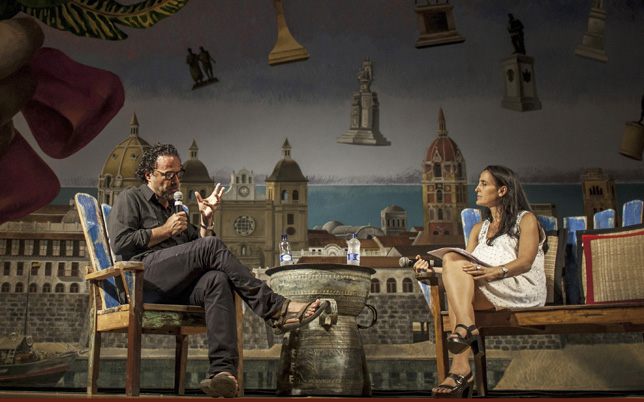
- Industry
Cartagena Film Festival
The Cartagena Film Festival is the largest and oldest in South America and celebrates mostly Latin American films. The 54th Edition of the festival directed by Monika Wagenberg, which just concluded, featured counting 12 South American films in the official competition, most of them premieres. The festival opened on March 13 in the beautiful Plaza de l’Aduana in the historical Old Town Cartagena, where a huge screen and stage had been built, with the Colombian film Ciudad Delirio by Chus Gutierrez, a comedy set in the world of salsa dancing and music in Cali; the festival closed on March 19th with John Turturro’s movie Fading Gigolo, featuring Turturro along with Woody Allen, Sofia Vergara and Sharon Stone. In between, over 100 films were shown in three main competitions, 5 retrospectives, along with the Encuentros Cartagena industry sidebar, which holds a Producers Meeting, and Documentary, Film Journalism, and Film Festivals Workshops.
While one of FICCI’s main goals is supporting the development of Colombian cinema, the festival offered several retrospectives of films from major filmmakers: Alejandro Gonzalez Iñárritu, Abbas Kiarostami, John Sayles, Clive Owen and Pawel Pawlikoski. The festival also celebrated old Italian comedy, with black and white films by Federico Fellini, Vittorio De Sica and Mario Monicelli in one of the open theatres in a square in old town. In Cartagena most of the films of the festival are shown within the walls of Cartagena’s old town, primarily in the TAM theatre, and in a large square just outside the wall by the Clock Tower, where this year Colombian singer Adriana Lucia showed her documentary on the origins of “porro” music and dance and later performed for the audience. The films are also shown in a very modern multiplex in a shopping mall about 15 minutes taxi drive from the Old Town. Cartagena’s policy of offering free cinema entrance to the public proved to be a winning proposition, with festival director Monika Wagenberg revealing during the closing ceremony that 110,000 people attended screenings in 2014, a rise of 30 percent from the previous year. If large audience were constantly filling the theaters, the special guests in attendance received as much attention in the press conferences and Master classes held in the historical building of the Centro de Cooperacion Española in Old Town. Iñárritu, considered one of the most important representatives of Mexican cinema, expressed to the audience after a screening of his Amores Perros his appreciation for his friend Alfonso Cuarón, who this year won the Oscar as best director for his film Gravity. “Alfonso is a Maestro,” said Iñarritu, “I always say that he teaches all of us that good cinema doesn’t mean having money, but to be able to see what nobody else does.”
The Latin American premier of Clive Owen’s latest film, Guillaume Canet’s Blood Ties (2013), was a highlight on Friday, March 14, when the British actor received the India Catalina prize. In meeting the international journalists and students the following day, Owen talked about his origins in the theater, his style of preparing for a role, and about the new 10-hour series he just finished shooting, The Knick, directed for television by Steven Soderbergh and set in turn of the century New York, in a hospital where, 30 years before the arrival of antibiotics and penicillin, surgery was extremely innovative, experimental and, to say the least, very bloody.
The revered Iranian director Abbas Kiarostami talked at length with students from the University of Bogotá, who presented some of the shorts they made in school; Kiarostami discussed his choices of stories, visuals, the lack of music in his films – “except at the end, also so that people know the movie is ending”, he said jokingly – and encouraged students to continue working on telling the truth in their films and following their passions even in the face of the artistic and political repression that some of the students were lamenting.
The John Sayles retrospective featured more than a dozen of his most important films including his latest work, Casi dos Hermanas. Sayles discussed his career in independent films as well as his lesser known work as a screenwriter, including for directors like Steven Spielberg, which has allowed him over the years to self finance most of his films. Soderbergh chose to speak Spanish most of the time, a language he self-taught years ago when preparing for a film about immigrants in Miami.
The Official Dramatic Competition featured the Latin American premieres The Lock Charmer (El Cerrajero) by Natalia Smirnoff (Argentina), Natural Sciences (Ciencias Naturales) by Matías Lucchesi (Argentina), The Way He Looks (Hoje Eu Quero Voltar Sozinho) by Daniel Ribeiro (Brazil), Celina Murga’s Berlin Official Competition, The Three Sides of the River (La tercera orilla) (Argentina), recent Sundance and Rotterdam winner, To Kill a Man (Matar a un hombre) by Alejandro Fernández Almendras (Chile), Mateo, first film by Maria Gamboa (Colombia), and the world premiere of Dust on the Tongue (Tierra en la lengua) by Ruben Mendoza (Colombia).
Colombian writer-director Ruben Mendoza’s rural drama Dust on the Tongue, an offbeat, intense piece about the younger generation’s revenge on a tyrannical, patriarchal grandfather, took the Best Film award in the form of an India Catalina statuette. In the Colombia competition, the winner was Mark Grieco’s Colombia/U.S. co-produced documentary Marmato, about the face-off between a Canadian multinational and a Colombian mountain community over the issue of open-pit mining. Marmato also took the audience award.
Silvia Bizio

